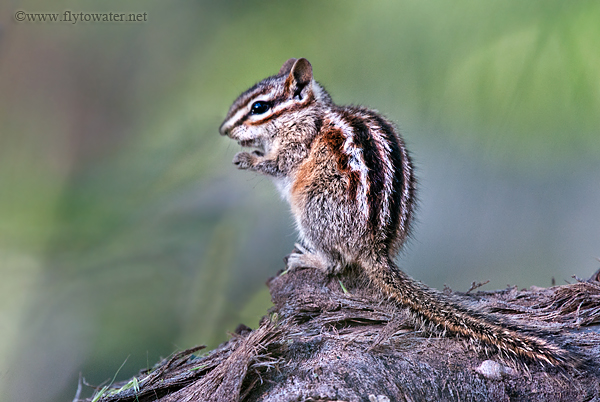With camera and grip attached, this rig weighs in around 13 pounds. I often carry this lens without a pack, and shoot it hand held. Mature bull elk in areas where hunting is prevalent are a cagey bunch, and opportunities can last only seconds.
In this case, however, I hiked over an area roughly the size of the Louisiana Purchase and didn't catch a single glimpse of elk hide.
As I was making the steep descent back to the vehicle, I came across a common Least Chipmunk, neotamias minimus.
A few things jumped out at me when I spotted this little guy.
- He was facing towards the sun, allowing for the all-important catch light to be reflected in his eye. This is a small detail that is always on my mind when photographing animals.
- The chipmunk was positioned on a log that would give the foreground some texture, as well as a little elevation from the grasses on the forest floor.
- Most interesting was the pattern of pine needles and leaves in the foliage beyond the perch. I immediately knew this would make for a soft, dappled, pleasing background.
The final step involved compositional fundamentals.
- It is key in wildlife portraits to shoot at eye level. I had to get very close to the ground to accomplish this, but it's important because downward angles in photography weaken the subject's presence in the image.
- The chipmunk's eye is located 1/3 of the frame from the top edge, which is a foundational element of the Rule of Thirds as it applies to portraits.
- Lastly, I chose a position that allowed the chipmunk's tail to enter at the corner, creating a natural leading line for the eye to easily follow into the photo.

Nikon D300
Nikon 400mm f/2.8 AF-S VR (hand held) - f/5.6, 1/250
LensCoat Camoflauge
Equivalent Optical Magnification: 8x
Sitka Gear Open Country Camo
Distance to Subject: 20 feet
Nikon 400mm f/2.8 AF-S VR (hand held) - f/5.6, 1/250
LensCoat Camoflauge
Equivalent Optical Magnification: 8x
Sitka Gear Open Country Camo
Distance to Subject: 20 feet









No comments:
Post a Comment